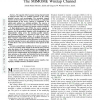Free Online Productivity Tools
i2Speak
i2Symbol
i2OCR
iTex2Img
iWeb2Print
iWeb2Shot
i2Type
iPdf2Split
iPdf2Merge
i2Bopomofo
i2Arabic
i2Style
i2Image
i2PDF
iLatex2Rtf
Sci2ools
CORR
2010
Springer
2010
Springer
Secure Transmission with Multiple Antennas II: The MIMOME Wiretap Channel
The capacity of the Gaussian wiretap channel model is analyzed when there are multiple antennas at the sender, intended receiver and eavesdropper. The associated channel matrices are fixed and known to all the terminals. A computable characterization of the secrecy capacity is established as the saddle point solution to a minimax problem. The converse is based on a Sato-type argument used in other broadcast settings, and the coding theorem is based on Gaussian wiretap codebooks. At high signal-to-noise ratio (SNR), the secrecy capacity is shown to be attained by simultaneously diagonalizing the channel matrices via the generalized singular value decomposition, and independently coding across the resulting parallel channels. The associated capacity is expressed in terms of the corresponding generalized singular values. It is shown that a semiblind "masked" multi-input multi-output (MIMO) transmission strategy that sends information along directions in which there is gain to th...
| Added | 09 Dec 2010 |
| Updated | 09 Dec 2010 |
| Type | Journal |
| Year | 2010 |
| Where | CORR |
| Authors | Ashish Khisti, Gregory W. Wornell |
Comments (0)

